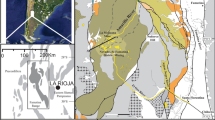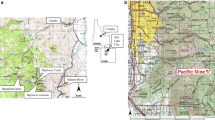Abstract
A sulfur and trace element enriched U–Th-laced tailings pile at the abandoned Phillips Mine in Garrison, New York, releases acid mine drainage (AMD, generally pH < 3, minimum pH 1.78) into the first-order Copper Mine Brook (CMB) that drains into the Hudson River. The pyrrhotite-rich Phillips Mine is located in the Highlands region, a critical water source for the New York metro area. A conceptual model for derivation/dissolution, sequestration, transport and dilution of contaminants is proposed. The acidic water interacts with the tailings, leaching and dissolving the trace metals. AMD evaporation during dry periods concentrates solid phase trace metals and sulfate, forming melanterite (FeSO4·7H2O) on sulfide-rich tailings surfaces. Wet periods dissolve these concentrates/precipitates, releasing stored acidity and trace metals into the CMB. Sediments along CMB are enriched in iron hydroxides which act as sinks for metals, indicating progressive sequestration that correlates with dilution and sharp rise in pH when mine water mixes with tributaries. Seasonal variations in metal concentrations were partly attributable to dissolution of the efflorescent salts with their sorbed metals and additional metals from surging acidic seepage induced by precipitation.





Similar content being viewed by others
References
Ames LL, McGarrah JE, Walker BA (1983) Sorption of trace constituents from aqueous solutions onto secondary minerals. I. Uranium. Clays Clay Mine 31:321–334
Bayless ER, Olyphant GA (1993) Acid-generating salts and their relationship to the chemistry of groundwater and storm runoff at an abandoned mine site in southwestern Indiana, USA. J Contam Hydrol 12:313–328
Beaulieu BT, Savage KS (2005) Arsenate adsorption structures on aluminum oxide and phyllosilicate mineral surfaces in smelter-impacted soils. Environ Sci Technol 39:3571–3579
Belzile N, Chen Y, Cai M, Li Y (2004) A review on pyrrhotite oxidation. J Geochem Explor 84:65–76
Bigham JM, Schwertmann U, Traina SJ, Winland RL, Wolf M (1996) Schwertmannite and the chemical modeling of iron in acid sulfate waters. Geochim Cosmochim Acta 60:2111–2121
Blowes DW, Jambor JL (1990) The pore-water geochemistry and the mineralogy of the vadose zone of sulfide tailings, Waite Amulet, Quebec, Canada. Appl Geochem 5:327–346
Campbell DL, Grauch RI (1977) Ground magnetic, E-mode VLF, and radiometric surveys at Phillips Mine-camp Smith uranium prospect. US Geol Survey Open-file Report. Westchester and Putnam Counties, pp 77–780
Centeno LM, Faure G, Lee G, Talnagi J (2004) Fractionation of chemical elements including the REEs and 226Ra in stream contaminated with coalmine effluent. Appl Geochem 19:1085–1095
Cravotta CA III (1994) Secondary Iron-sulfate minerals as sources of sulfate and acidity. In: Alpers CN, Blowes DW (eds) of the 204th National Meeting of the American Chemical Society, pp 345–364
Drake AA Jr (1984) The reading prong of New Jersey and eastern Pennsylvania: an appraisal of rock relations and chemistry of a major Proterozoic terrane. In: Appalachians. Geol Soc Am Special Paper 194:75–109
Fahringer P, Wilson T (2002) Shallow EM investigations of AMD at an abandoned coalmine in northern West Virginia. Lead Edge 21:478–481
Filipek LH, Nordstrom DK, Ficklin WH (1987) Interaction of acid mine drainage with waters and sediments of west Squaw Creek in the west Shasta mining district, California. Environ Sci Technol 21:388–396
Frau F (2000) The formation-dissolution-precipitation cycle of melanterite at the abandoned pyrite mine of Genna Luas in Sardinia, Italy: environmental implications. Mineral Mag 64:995–1006
Gilchrist S (2008) Acid mine drainage in small watershed in the Hudson river drainage basin: geochemistry/degradation of soil, sediment and water quality, Rutgers University, PhD dissertation
Hammarstrom JM, Seal RR II, Meier AL, Kornfeld JM (2005) Secondary sulfate minerals associated with acid drainage in the eastern US: recycling of metals and acidity in surficial environments. Chem Geol 215:407–431
Harris DL, Lottermoser BG, Duchesne J (2003) Ephemeral acid mine drainage at the Montalbion silver mine, north Queensland. Aust J Earth Sci 50:797–809
Hem JD (1989) Study and interpretation of the chemical characteristics of natural water. United States Geol Survey, Water Supply Paper 3rd Ed 2254
Hsi C-KD, Langmuir D (1985) Adsorption of uranyl onto ferric oxyhydroxides: application of the surface complexation site-binding model. Geochim Cosmochim Acta 49:1931–1941
Jerz JK, Rimstidt JD (2003) Efflorescent iron sulfate minerals: Paragenesis, relative stability, and environmental impact. Am Mineral 88:1919–1932
Kabata-Pendias A, Pendias H (1984) Trace elements in soils and plants. CRC Press, Boca Raton
Keith DC, Runnells DD, Esposito KJ, Chermak JA, Levy DB, Hannula SR, Watts M, Hall L (2001) Geochemical models of the impact of acidic groundwater and evaporative sulfate salts on Boulder Creek at Iron Mountain, California. Appl Geochem 16:947–961
Kemp JF (1894) The nickel mine at Lancaster Gap, Pennsylvania, and the pyrrhotite deposits at Anthony’s Nose, on the Hudson. Am Inst Mining EngTrans 24:620–633
Kimball BA, Church SE (1997) Effects of colloidal iron and aluminum on the transport and transformation of metals in rivers affected by mine drainage. In: Proceedings of the US Geol Survey (USGS) Sediment Workshop, 4–7 Feb, 1997
Klemic H, Eric JH, McNitt JR, McKeown FA (1959) Uranium in Phillips Mine-camp Smith area, Putnam and Westchester Counties, New York. US Geol Survey Bull 1074–E:165–197
Langmuir D, Herman JS (1980) The mobility of thorium in natural waters at low temperatures. Geochim Cosmochim Acta 44:1753–1766
Lee G, Bigham JM, Faure G (2002) Removal of trace metals by co-precipitation with Fe, Al and Mn from natural waters contaminated with acid mine drainage in the Ducktown Mining District, Tennessee. Appl Geochem 17:569–581
Long ER, Morgan LG (1990) The potential for biological effects of sediment-sorbed contaminants tested in the National Status and Trends Program: Seattle, Wash., National Oceanic and Atmospheric Administration, NOAA Technical Memorandum NOS OMA 62, 175p
Loveman MH (1911) Geology of the Phillips Pyrites Mine near Peekskill, New York. Econ Geol 6:231–246
Lupulescu M, Gates A (2006) Iron deposits from Hudson Highlands, NY: Systematics, Mineralogy, Mineral Chemistry and Tectonic setting in environmental geology of the Highlands, field guide and Proceedings, 23rd Annual Conference and Field Trip, Geological Association of New Jersey, p 116
Munk LA, Faure G, Pride DE, Bigham JM (2002) Sorption of trace metals to an aluminum precipitate in a stream receiving acid rock-drainage; Snake River, Summit County, Colorado. Appl Geochem 17:421–430
Nordstrom DK, Alpers CN (1999) Geochemistry of acid mine waters. Rev Econ Geol 6A:133–160
Olyphant GA, Bayless ER, Harper D (1991) Seasonal and weather-related controls on solute concentrations and acid drainage from a pyritic coal-refuse deposit in southwestern Indiana, USA. J Contam Hydrol 7:219–236
Osmond JK, Cowart JB (1976) The theory and uses of natural uranium isotopic variations in hydrology. At Energy Rev 14:621–679
Paulson AJ (1997) The transport and fate of Fe, Mn, Cu, Zn, Cd, Pb, and SO4 in a groundwater plume and in downstream surface waters in the Coeur d’Alene Mining District, Idaho, USA. Appl Geochem 12:447–464
Persaud D, Jaagumaji R, Hayton A (1993) Guidelines for the protection and management of aquatic sediment quality in Ontario. ISBN 0-7729-9248-7. Ontario Ministry of the Environment, Ottawa, Ontario, 23p
Pratt AR, Nesbitt HW, Mycroft JR (1996) The increased reactivity of pyrrhotite and magnetite phases in sulphide mine tailings. J Geochem Explor 56:1–11
Puffer JH, Asemota I (1986) Sulfide mineral distribution of Northern New Jersey rock formations and their surface drainage induced acid generating capacity. Center for Coastal and Environmental Studies, Division of Water Resources, Rutgers University, New Brunswick. Final Report
Ransom JM (1966) Vanishing ironworks of the Ramapos: the story of the forges, furnaces, and mines of the New Jersey-New York area. Rutgers University Press, New Brunswick
Reimann C, Siewers U, Skarphagen H, Banks D (1999) Influence of filtration on concentrations of 62 elements analysed on crystalline bedrock groundwater samples by ICP-MS. Sci Total Environ 234:155–173
Root RA, Dixit S, Campbell KM, Jew AD, Hering JG, O’Day PA Arsenic sequestration by sorption processes in high-iron sediments. Geochim Cosmochim Acta (in press)
Singer PC, Stumm W (1970) Acidic mine drainage: the rate-determining step. Science 167:1121–1123
Smock JC (1889) Iron mines and iron-ore districts in the state of New York. New York State Museum Bull No. 7
Szabo Z, dePaul VT, Kraemer TF, Parsa B (2005) Occurrence of radium-224 and comparison to that of radium-226 and radium-228 in water from the unconfined Kirkwood-Cohansey aquifer system, Southern New Jersey. US. Geological Survey Scientific Investigations Report 2004–5224, p 101 http://pubs.er.usgs.gov/pubs/sir/sir20045224. Cited 12/9/2005
The Highlands Coalition (2003) http://www.highlandscoalition.org/home.html. Cited 2003
United States Geological Survey (USGS) (2005) Preparations for water sampling. TWRI Book 9, Chapter A1 (Version 2.0, 1/05) http://water.usgs.gov/owq/FieldManual/chapter1/pdffiles/Ch1.pdf
Volkert RA, Zartman RE, Moore PB (2005) U-Pb zircon geochronology of Mesoproterozoic postorogenic rocks and implications for post-Ottawan magmatism and metallogenesis, New Jersey Highlands and contiguous areas, USA. Precambrian Res 139:1–19
Wang S, Mulligan CN (2006) Effect of natural organic matter on arsenic release from soils and sediments into groundwater. Environ Geochem Health 28:197–214
Waychunas GA, Kim CS, Banfield JF (2005) Nanoparticulate iron oxide minerals in soils and sediments: unique properties and contaminant scavenging mechanisms. J Nanopart Res 7:409–433
Zapecza OS, Rice DE, dePaul VT (2003) New York–New Jersey Highlands technical report. In: Hoppe M (ed) Section 1. Water Resources. NA-TP-04-03, USDA forest service. Northeastern Area State and Private Forestry, Newtown, pp 1–44
Acknowledgments
The authors gratefully acknowledge the analytical support provided by USGS, Denver, CO; laboratory assistance and XRD support by Dr Matthew Gorring, Montclair State University; SEM–EDS support by Dr Marian Lupulescu, New York State Museum, and Dr David Bailey, Hamilton College. Gratitude is also extended to the following individuals who provided field and analytical assistance with the research: Dr Alan Gilchrist, Dr Yuxin Wu and Sweeta Chauhan. The Dorr Foundation and the J. M. Kaplan Fund granted to Dr Alexander Gates provided financial support for this work.
Author information
Authors and Affiliations
Corresponding author
Rights and permissions
About this article
Cite this article
Gilchrist, S., Gates, A., Szabo, Z. et al. Impact of AMD on water quality in critical watershed in the Hudson River drainage basin: Phillips Mine, Hudson Highlands, New York. Environ Geol 57, 397–409 (2009). https://doi.org/10.1007/s00254-008-1310-4
Received:
Accepted:
Published:
Issue Date:
DOI: https://doi.org/10.1007/s00254-008-1310-4




